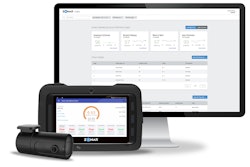Canada’s Transport Ministry — the country’s equivalent of the U.S. Department of Transportation — this month announced that it has finalized a mandate to require the use of electronic logging devices, and carriers must replace paper logs with ELDs by June 12, 2021, to remain compliant.
The mandate is similar to that of the U.S. mandate, which took effect December 2017, particularly the Canadian mandate’s device requirements, meaning ELD providers won’t need to make new devices that comply with the mandate. Rather, the differences will be software-based, to ensure that ELDs track hours of service relative to Canada’s regulations.
In a press release issued June 13, Canada’s Transport Ministry said its ELD requirements “are aligned with the United States road safety regulations and will support economic growth, trade and transportation on both sides of the border.”
Eric Witty, vice president of product at Trimble (formerly PeopleNet), says there will be little discernible difference in the way drivers will use ELDs in the two countries, despite differences in underlying hours of service regulations and differences like use of personal conveyance under Canadian rules. (Canadian regulations allow for 75 kilometers a day of personal conveyance, with stricter requirements about its use. For instance, Canadian regs require the truck to be unhooked from the trailer before it can be used for personal conveyance, where as U.S. regulations allow for use of personal conveyance in certain situations even if the truck is loaded and hooked to a trailer.)
A major difference between the two mandates, however, is the certification requirements of the devices. Whereas the U.S. allows manufacturers to self-certify that their devices meet the standards set by the mandate, Canada will require a third-party body to certify ELDs — a more stringent standard than the U.S.
How that process will work is still being defined, says Witty, and the certification requirements are still unclear for device providers. (CCJ will explore this topic more in-depth this week.)
Another significant difference is with the roadside inspection process. Canadian ELDs will not be required to transmit a raw data (.CSV) file to the officer that contains the driver’s log records for past seven days and the current day. In the U.S., devices can transfer the logbook file to officers wirelessly through web services and email or through Bluetooth and a USB drive. In any instance, the data file is sent to a cloud-based ERODs system that audits the logs.
The Canadian ELD rule only requires that devices be able to transmit a report of the driver’s past 14 days record of duty status. This report could be a PDF document that is sent to the officer at a roadside inspection via email, Bluetooth or a USB drive, explains Andy Oleson, senior solutions engineer at Platform Science, an ELD and telematics provider.
Carriers who operate cross-border will need to use a device certified via both countries processes. When making a true cross-border run, ELDs will likely only need to enter a different mode, either Canadian or U.S., to remain compliant. That switch could happen automatically, says Witty, based on location, though some devices may require input from the driver. Either way, ELDs will then update factors like remaining on-duty and drive time based on hours already operated during that shift and the hours of service regulations of each country.
However, the point may be moot. Carriers operating cross-border — either Canadian or Mexican carriers operating in the U.S. and U.S. carriers operating into Canada and Mexico — are already required to have ELDs to operate in the U.S, save for the exemptions afforded under the U.S. mandate.
According to information reported in the Canada Gazette, the number of regulated commercial vehicles in Canada is approximately 175,000. About 145,000 of these vehicles would have to have electronic logs, of which 80,000 do cross-border operations and as such are already compliant with the ELD regulation in the United States. This means that about 65,000 vehicles will need to install ELDs before June 2021. The Canada Gazette is the government’s regulatory docket, similar to the Federal Register in the U.S.
Also unlike the U.S. mandate, there will be no transitional period when carriers can use the less-sophisticated automatic onboard recording devices (AOBRDs) to comply with the mandate. The U.S. mandate allows carriers to use AOBRDs until December 2019. Canada’s mandate requires use of fully compliant devices by the June 12, 2021, deadline.












